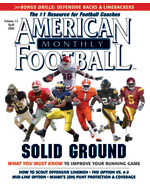AMERICAN FOOTBALL MONTHLY THE #1 RESOURCE FOR FOOTBALL COACHES
Article CategoriesAFM Magazine
|
Effective Grading Strategiesby: Ryan Dean Ruschhaupt© More from this issue Grading players should be easy, effortless and not take hours to do. Our system will utilize a check box numbering system that allows coaches to rate players easily and effectively. We will use three major criteria for determining a player’s ability at each play: Alignment, Assignment and Hustle. Once a player has been graded a more complete picture will aid the coach in determining what a player needs to work on. For example: A player might consistently be in a poor alignment yet his hustle grade shows that he has a great attitude and desire to make a play. He obviously needs to spend more time learning his playbook. The eye in the sky never lies! Grading Scale: 1-5 1. Very Poor Grade; the player has poor athletic ability and a poor understanding of ....The full article can only be seen by subscribers. Subscribe today!
|
|
|||||||
| HOME |
MAGAZINE |
SUBSCRIBE | ONLINE COLUMNISTS | COACHING VIDEOS |
Copyright 2025, AmericanFootballMonthly.com
All Rights Reserved





